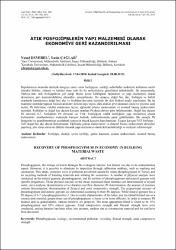| dc.contributor.author | Demirel, Yusuf | |
| dc.contributor.author | Caglar, Yasin | |
| dc.date.accessioned | 2020-06-25T18:15:46Z | |
| dc.date.available | 2020-06-25T18:15:46Z | |
| dc.date.issued | 2015 | |
| dc.identifier.citation | Demirel Y., Çağlar Y. (2015). Atık Fosfojipslerin Yapı Malzemesi Olarak Ekonomiye Geri Kazandırılması. Gazi Üniversitesi Mühendislik Mimarlık Fakültesi Dergisi, 30(4), 743 - 750. | en_US |
| dc.identifier.issn | 1300-1884 | |
| dc.identifier.issn | 1304-4915 | |
| dc.identifier.uri | https://hdl.handle.net/20.500.12587/6269 | |
| dc.description | WOS: 000368517800020 | en_US |
| dc.description.abstract | Phosphogypsum, the storage of which damages the ecological balance, has limited use due to its contamination aspect. However, it is possible to eliminate its impurities through raffination methods, such as washing and calcination. This study, examines ways of pollution prevention caused by waste phosphogypsum in Turkey and its recycling methods of building materials and winning for economics. A number of physical analysis were conducted on the natural gypsum, phosphogypsum, and the mixture of phosphogypsum and natural gypsum with specific proportions. These physical analysis on the abone mentioned three materials are determination of crystal water, sieve analysis, determination of set duration and flow diameter, Ph determination, the amount of moisture content determination, determination of flexural and axial compressive strength. The proportional mixture of phosphogypsum and natural gypsum are determined according to their Ph degrees. While natural gypsum has a Ph degree of 6-7, phosphogypsum has 3. Due to asidic characteristic of the latter, and its related limited use as a consturction material, proportional use of phosphogypsum is found to be more efficient. In order to measure Ph balance and its granulometer, various mixtures are prepared. The most appropriate blend is found to be 15% phosphogypsum and 85% natural gypsum. Axial compressive strength and flexural strength tests were conducted, setting duration has been taken into account, outdoor use as construction material and its cost have been discussed. | en_US |
| dc.language.iso | tur | en_US |
| dc.publisher | Gazi Univ, Fac Engineering Architecture | en_US |
| dc.rights | info:eu-repo/semantics/closedAccess | en_US |
| dc.subject | Phosphogypsum | en_US |
| dc.subject | ecology | en_US |
| dc.subject | environmental pollution | en_US |
| dc.subject | recycling | en_US |
| dc.subject | flexual strength | en_US |
| dc.subject | axial compressive strength | en_US |
| dc.title | Recovery Of Phosphogypsum In Economy In Building Materialwaste | en_US |
| dc.type | article | en_US |
| dc.contributor.department | Kırıkkale Üniversitesi | en_US |
| dc.identifier.volume | 30 | en_US |
| dc.identifier.issue | 4 | en_US |
| dc.identifier.startpage | 743 | en_US |
| dc.identifier.endpage | 750 | en_US |
| dc.relation.journal | Journal Of The Faculty Of Engineering And Architecture Of Gazi University | en_US |
| dc.relation.publicationcategory | Makale - Uluslararası Hakemli Dergi - Kurum Öğretim Elemanı | en_US |
















